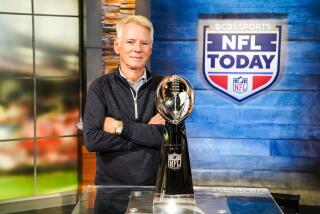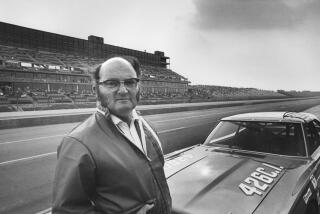Hurrah for the Next Man Who Dies : by Mark Goodman (Atheneum: $14.95; 272 pp.)
- Share via
These days, America follows so many sports that only the terminally sports-obsessed can remember the name of last week’s contender. Former sportswriter Mark Goodman’s docu-novel, “Hurrah for the Next Man Who Dies,” re-creates an earlier, elite world, when “National Football Champions” meant Princeton, Harvard or Yale, and “hero” meant Hobart Armory Hare Baker, the golden-haired Princetonian.
To achieve the modern-day equivalent of Hobey Baker’s fame, Heisman Trophy winner Doug Flutie would also have to be an ice hockey star, playing before cheering society folk in evening clothes. After college, Flutie would have to disdain money and a professional contract for a “gentleman’s” hockey team. Finally, Flutie would have to become a flying ace and then die young, a war hero in a good war. We shall not see Hobey Baker’s like again.
Nearly 20 years ago, John Davies wrote a biography, “The Legend of Hobey Baker,” complete with game stats and team photographs of earnest young men squinting toward the camera. Mark Goodman’s novel is a better book. He brings Baker to life through the eyes of a fictional adoring schoolmate, later college teammate and fellow pilot. Through Jeb Runcible, we see what Baker means to a contemporary who can only aspire to the level of sportsmanship and achievement that Baker so effortlessly attains.
Goodman shows us the limitation of the ideal. In the last days of World War I, ace fighter-pilot Baker volunteers his men for fruitless and dangerous missions, as if combat were the big game--Princeton versus Yale. Jeb is shot down. Trying to scramble back behind his own lines, he saves himself by killing a teen-age German in the bloody trenches. Jeb discovers that the real war is not the sanitized, high-flying gentleman’s sport that is Hobey Baker’s obsession. By Armistice Day, Baker himself seems to realize that there will be no place for his individualistic heroics in adult civilian life. Baker’s last doomed flight to test an underling’s faulty plane seems like suicide.
Goodman is at his best bringing to life Hobey Baker’s long-forgotten games on the playing fields and in the air over France. Davies’ breathless sports bio is not, however, Goodman’s only competition. Long ago, F. Scott Fitzgerald gave Hobey Baker a cameo in “This Side of Paradise” as “Allenby, the football captain, slim, defiant.”
Goodman’s first novel shares with the early Fitzgerald not only the period and the aristocratic milieu, but also an overwrought style. Goodman writes, for example, “When I came East, I also encountered what became my favorite harbinger of autumn--not a bird with breast of red, but a more clamorous and colorful species of fauna: Old Grad. Old Grad came draped in arctic furs against the pleasant afternoon sunshine, bedizened and beribboned with a score of black-and-orange adornments.” Goodman also imitates--to good effect, to be sure--Fitzgerald’s later use of the participant narrator in “The Great Gatsby.” Because of the extent of the homage to Fitzgerald, “Hurrah for the Next Man Who Dies” sometimes seems like an exercise.
Nevertheless, except for an unfortunate tendency to tell the outcome of an episode first, Mark Goodman writes well. When he finds his own subject and his own voice, he will write even better. In the meantime, his first novel tells a rousing story and asks some good questions about America’s obsession with sports and sports heroes.
More to Read
Go beyond the scoreboard
Get the latest on L.A.'s teams in the daily Sports Report newsletter.
You may occasionally receive promotional content from the Los Angeles Times.










